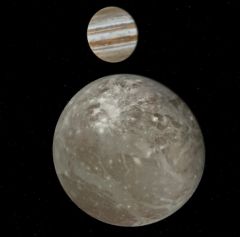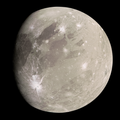Difference between revisions of "Ganymede"
Jump to navigation
Jump to search
(Added gallery.) |
(Added images to gallery.) |
||
| Line 67: | Line 67: | ||
<gallery> | <gallery> | ||
GanymedeOrbiter2002.jpg|<center>Ganymede in Orbiter 2002</center> | GanymedeOrbiter2002.jpg|<center>Ganymede in Orbiter 2002</center> | ||
| + | Ganymede - Perijove 34 Composite.png|<center>Ganymede as seen by the [[w:Juno (spacecraft)|Juno]] spacecraft in 2021</center> | ||
| + | Galilean moon Laplace resonance animation 2.gif|<center>Animation of three inner Galilean moons showing orbital resonance</center> | ||
</gallery> | </gallery> | ||
Revision as of 02:43, 1 August 2024
Ganymede is one of Jupiter's four Galilean Moons, the third from Jupiter. It is also the largest Natural Satellite in the Solar System and its diameter is larger than Mercury's by about 8%. Its orbit is in a 1:2:4 resonance with Io and Europa.
Ganymede in Orbiter
Ganymede was introduced to Orbiter in the Orbiter 2002 release. It is modeled as a sphere 2634 km in radius.
| Add-on | Source | Version | Author | Type | Release Date | Compatibility | Wiki article |
|---|---|---|---|---|---|---|---|
| Orbiter 2002 | O-F Resources | 020419 | martins | Orbiter Download | 19 April 2002 | Orbiter 2002 | |
See also
Gallery
Ganymede as seen by the Juno spacecraft in 2021
| edit The Solar System | |
|---|---|
| Central star |
Sun (Sol) |
| Planets |
Mercury - Venus - Earth - Mars - Jupiter - Saturn - Uranus - Neptune |
| Natural satellites |
Moon - Phobos - Deimos - Io - Europa - Ganymede - Titan - more... |
| Add-ons |
Planets - Dwarf Planets - Small objects - Natural satellites - Alternative star systems |
 | This natural satellite related article is a stub. You can help Orbiterwiki by expanding it.
|



